Low Emission Vehicle Project: UK Transport Industry Impact Analysis
VerifiedAdded on 2023/06/08
|67
|16369
|134
Project
AI Summary
This project is a comprehensive analysis of low emission vehicles (LEVs) and their impact on the UK transport industry. The research begins with an introduction to the concept of LEVs, discussing the background, rationale, problem statement, and research questions. A thorough literature review explores electric vehicles, control systems, and energy storage devices, providing a foundation for understanding the current state of LEV technology. The methodology section details the research philosophy, approach, design, data collection methods (including online surveys), and data analysis techniques, with justifications for each choice. The study utilizes quantitative data analysis, including regression analysis. The project also addresses ethical considerations and limitations. Findings and analysis are presented, followed by conclusions and recommendations for the development and implementation of LEVs within the UK transport sector. The research aims to identify issues within the industry, analyze the impact of LEVs, and propose strategies for market development, contributing to a reduction in emissions and improved urban air quality. The structure includes chapters on introduction, literature review, methodology, data findings and analysis, and conclusion and recommendations.
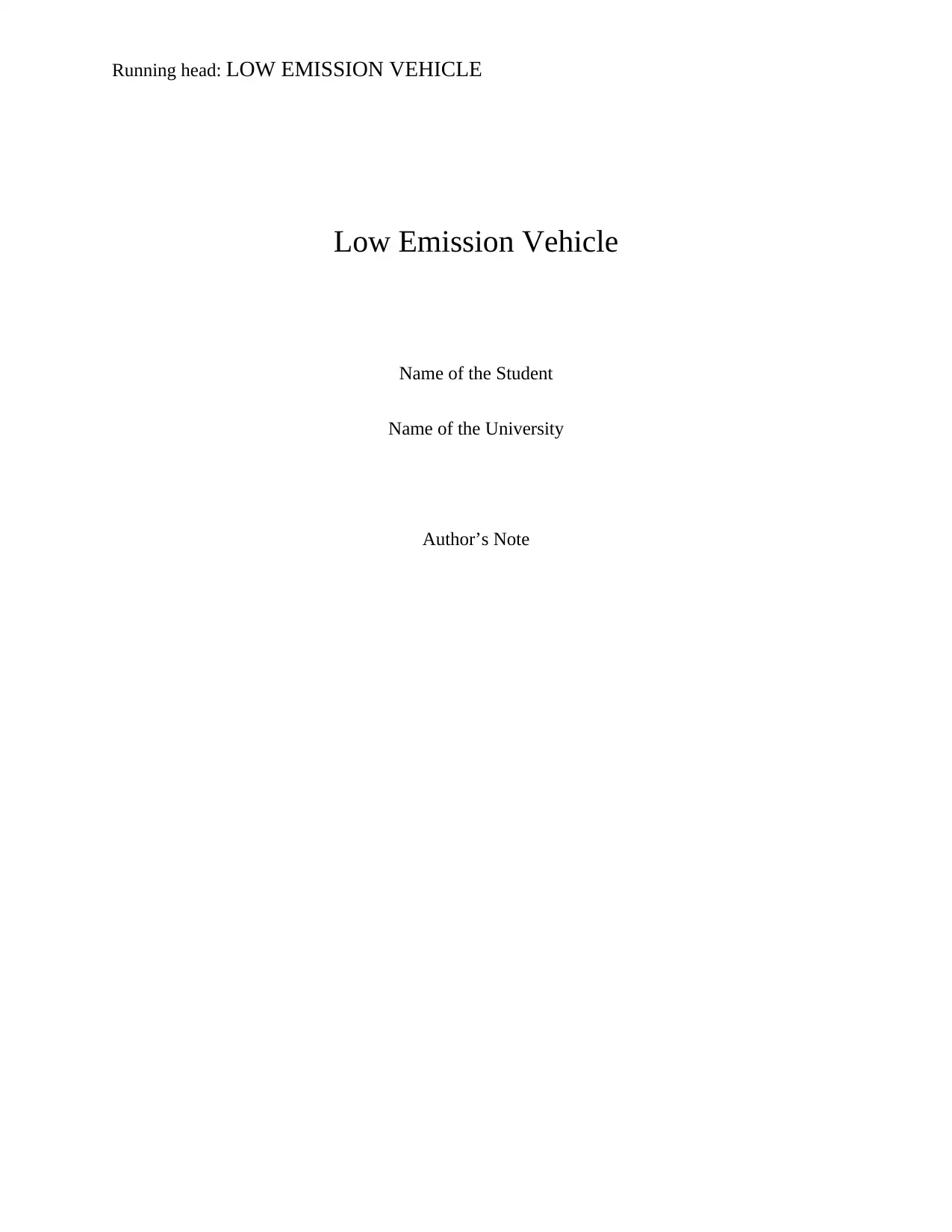
Running head: LOW EMISSION VEHICLE
Low Emission Vehicle
Name of the Student
Name of the University
Author’s Note
Low Emission Vehicle
Name of the Student
Name of the University
Author’s Note
Paraphrase This Document
Need a fresh take? Get an instant paraphrase of this document with our AI Paraphraser
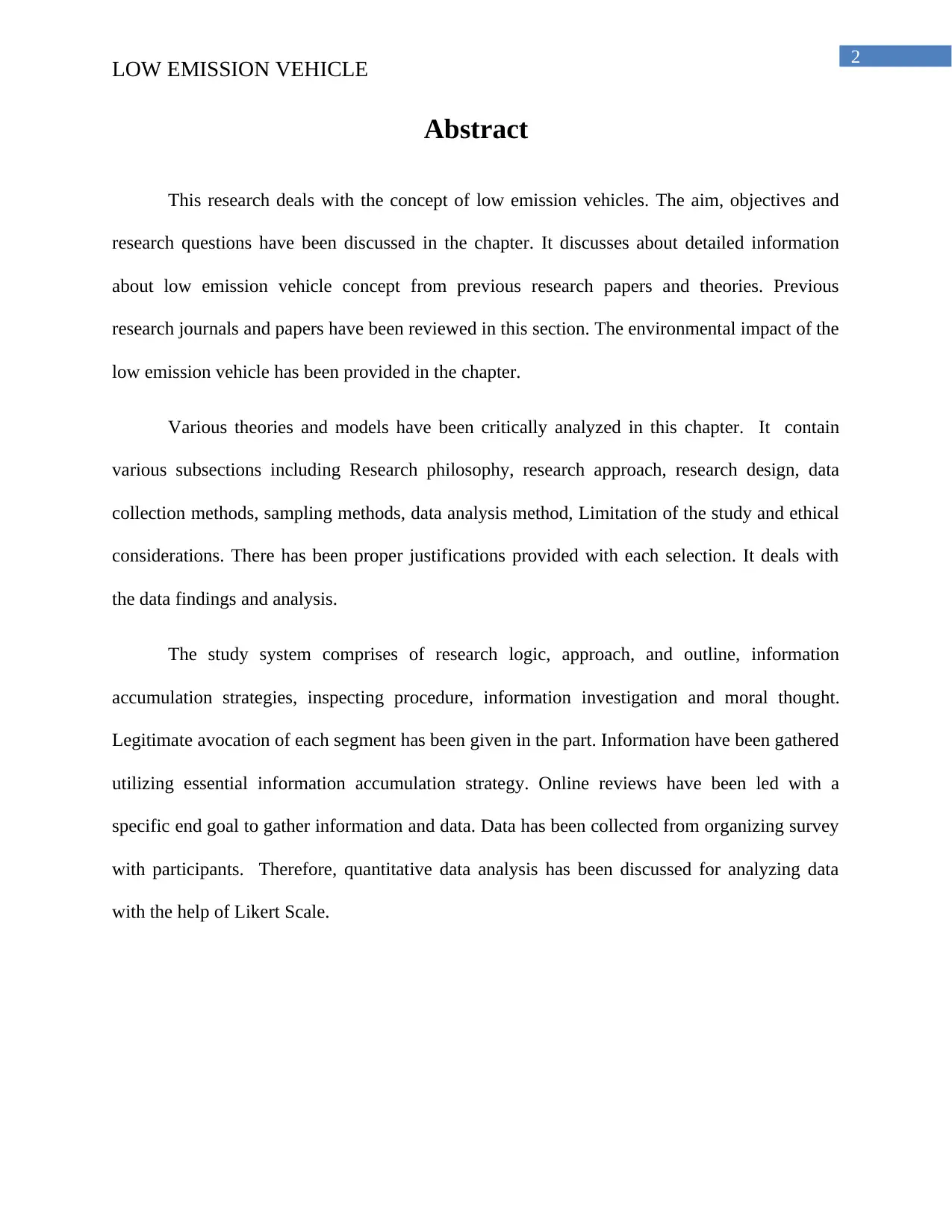
2
LOW EMISSION VEHICLE
Abstract
This research deals with the concept of low emission vehicles. The aim, objectives and
research questions have been discussed in the chapter. It discusses about detailed information
about low emission vehicle concept from previous research papers and theories. Previous
research journals and papers have been reviewed in this section. The environmental impact of the
low emission vehicle has been provided in the chapter.
Various theories and models have been critically analyzed in this chapter. It contain
various subsections including Research philosophy, research approach, research design, data
collection methods, sampling methods, data analysis method, Limitation of the study and ethical
considerations. There has been proper justifications provided with each selection. It deals with
the data findings and analysis.
The study system comprises of research logic, approach, and outline, information
accumulation strategies, inspecting procedure, information investigation and moral thought.
Legitimate avocation of each segment has been given in the part. Information have been gathered
utilizing essential information accumulation strategy. Online reviews have been led with a
specific end goal to gather information and data. Data has been collected from organizing survey
with participants. Therefore, quantitative data analysis has been discussed for analyzing data
with the help of Likert Scale.
LOW EMISSION VEHICLE
Abstract
This research deals with the concept of low emission vehicles. The aim, objectives and
research questions have been discussed in the chapter. It discusses about detailed information
about low emission vehicle concept from previous research papers and theories. Previous
research journals and papers have been reviewed in this section. The environmental impact of the
low emission vehicle has been provided in the chapter.
Various theories and models have been critically analyzed in this chapter. It contain
various subsections including Research philosophy, research approach, research design, data
collection methods, sampling methods, data analysis method, Limitation of the study and ethical
considerations. There has been proper justifications provided with each selection. It deals with
the data findings and analysis.
The study system comprises of research logic, approach, and outline, information
accumulation strategies, inspecting procedure, information investigation and moral thought.
Legitimate avocation of each segment has been given in the part. Information have been gathered
utilizing essential information accumulation strategy. Online reviews have been led with a
specific end goal to gather information and data. Data has been collected from organizing survey
with participants. Therefore, quantitative data analysis has been discussed for analyzing data
with the help of Likert Scale.

3
LOW EMISSION VEHICLE
Acknowledgement
I would like to thank all the people who helped me throughout the writing of this dissertation
project. I would like to thank wholeheartedly to my family members and my
supervisors_____________ who supported me throughout my time at the university. I would
also like to thank the University for providing the data which where helpful for my research
project. Finally, I would like to thank my course tutor ____________ who guided me throughout
the course.
LOW EMISSION VEHICLE
Acknowledgement
I would like to thank all the people who helped me throughout the writing of this dissertation
project. I would like to thank wholeheartedly to my family members and my
supervisors_____________ who supported me throughout my time at the university. I would
also like to thank the University for providing the data which where helpful for my research
project. Finally, I would like to thank my course tutor ____________ who guided me throughout
the course.
⊘ This is a preview!⊘
Do you want full access?
Subscribe today to unlock all pages.

Trusted by 1+ million students worldwide
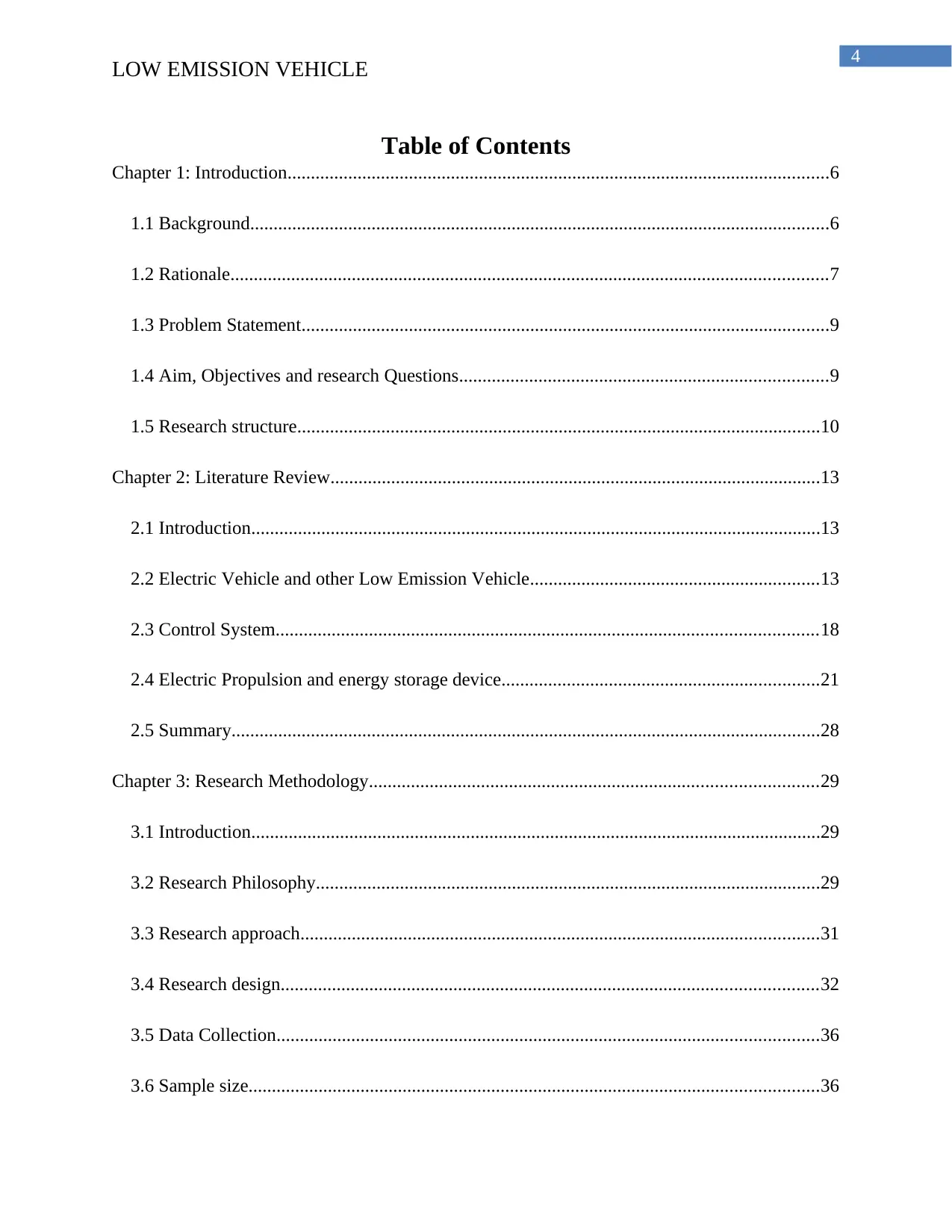
4
LOW EMISSION VEHICLE
Table of Contents
Chapter 1: Introduction....................................................................................................................6
1.1 Background............................................................................................................................6
1.2 Rationale................................................................................................................................7
1.3 Problem Statement.................................................................................................................9
1.4 Aim, Objectives and research Questions...............................................................................9
1.5 Research structure................................................................................................................10
Chapter 2: Literature Review.........................................................................................................13
2.1 Introduction..........................................................................................................................13
2.2 Electric Vehicle and other Low Emission Vehicle..............................................................13
2.3 Control System....................................................................................................................18
2.4 Electric Propulsion and energy storage device....................................................................21
2.5 Summary..............................................................................................................................28
Chapter 3: Research Methodology................................................................................................29
3.1 Introduction..........................................................................................................................29
3.2 Research Philosophy............................................................................................................29
3.3 Research approach...............................................................................................................31
3.4 Research design...................................................................................................................32
3.5 Data Collection....................................................................................................................36
3.6 Sample size..........................................................................................................................36
LOW EMISSION VEHICLE
Table of Contents
Chapter 1: Introduction....................................................................................................................6
1.1 Background............................................................................................................................6
1.2 Rationale................................................................................................................................7
1.3 Problem Statement.................................................................................................................9
1.4 Aim, Objectives and research Questions...............................................................................9
1.5 Research structure................................................................................................................10
Chapter 2: Literature Review.........................................................................................................13
2.1 Introduction..........................................................................................................................13
2.2 Electric Vehicle and other Low Emission Vehicle..............................................................13
2.3 Control System....................................................................................................................18
2.4 Electric Propulsion and energy storage device....................................................................21
2.5 Summary..............................................................................................................................28
Chapter 3: Research Methodology................................................................................................29
3.1 Introduction..........................................................................................................................29
3.2 Research Philosophy............................................................................................................29
3.3 Research approach...............................................................................................................31
3.4 Research design...................................................................................................................32
3.5 Data Collection....................................................................................................................36
3.6 Sample size..........................................................................................................................36
Paraphrase This Document
Need a fresh take? Get an instant paraphrase of this document with our AI Paraphraser
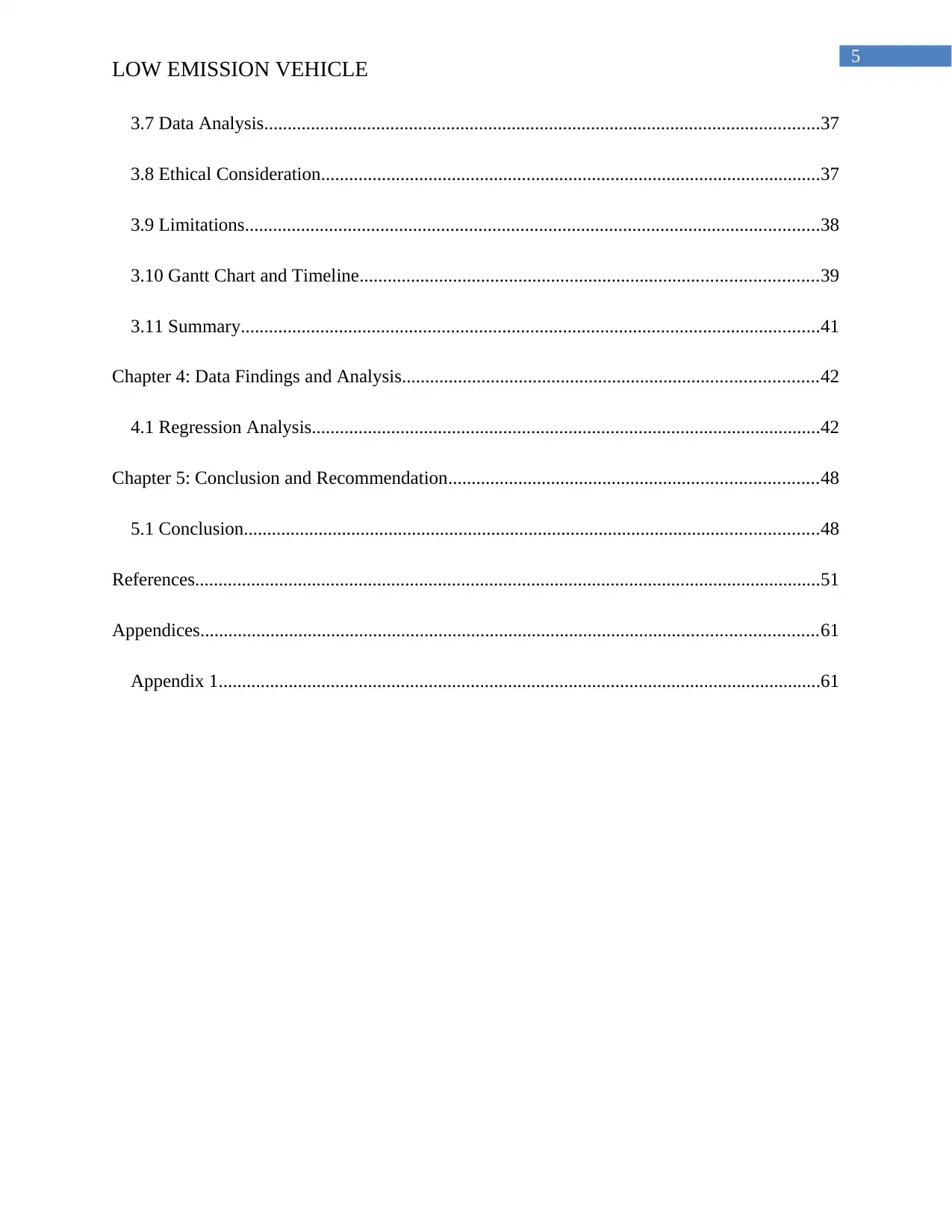
5
LOW EMISSION VEHICLE
3.7 Data Analysis.......................................................................................................................37
3.8 Ethical Consideration...........................................................................................................37
3.9 Limitations...........................................................................................................................38
3.10 Gantt Chart and Timeline..................................................................................................39
3.11 Summary............................................................................................................................41
Chapter 4: Data Findings and Analysis.........................................................................................42
4.1 Regression Analysis.............................................................................................................42
Chapter 5: Conclusion and Recommendation...............................................................................48
5.1 Conclusion...........................................................................................................................48
References......................................................................................................................................51
Appendices....................................................................................................................................61
Appendix 1.................................................................................................................................61
LOW EMISSION VEHICLE
3.7 Data Analysis.......................................................................................................................37
3.8 Ethical Consideration...........................................................................................................37
3.9 Limitations...........................................................................................................................38
3.10 Gantt Chart and Timeline..................................................................................................39
3.11 Summary............................................................................................................................41
Chapter 4: Data Findings and Analysis.........................................................................................42
4.1 Regression Analysis.............................................................................................................42
Chapter 5: Conclusion and Recommendation...............................................................................48
5.1 Conclusion...........................................................................................................................48
References......................................................................................................................................51
Appendices....................................................................................................................................61
Appendix 1.................................................................................................................................61
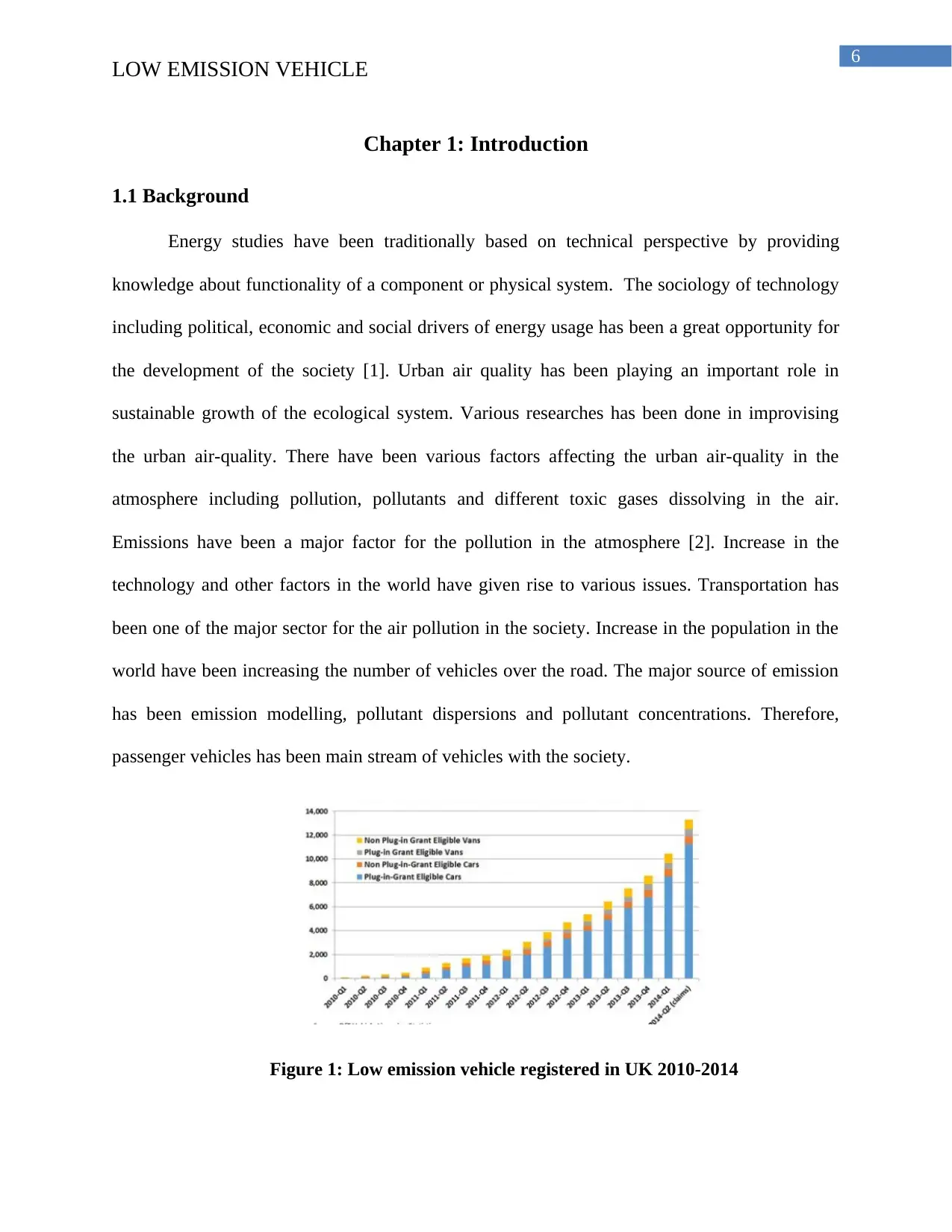
6
LOW EMISSION VEHICLE
Chapter 1: Introduction
1.1 Background
Energy studies have been traditionally based on technical perspective by providing
knowledge about functionality of a component or physical system. The sociology of technology
including political, economic and social drivers of energy usage has been a great opportunity for
the development of the society [1]. Urban air quality has been playing an important role in
sustainable growth of the ecological system. Various researches has been done in improvising
the urban air-quality. There have been various factors affecting the urban air-quality in the
atmosphere including pollution, pollutants and different toxic gases dissolving in the air.
Emissions have been a major factor for the pollution in the atmosphere [2]. Increase in the
technology and other factors in the world have given rise to various issues. Transportation has
been one of the major sector for the air pollution in the society. Increase in the population in the
world have been increasing the number of vehicles over the road. The major source of emission
has been emission modelling, pollutant dispersions and pollutant concentrations. Therefore,
passenger vehicles has been main stream of vehicles with the society.
Figure 1: Low emission vehicle registered in UK 2010-2014
LOW EMISSION VEHICLE
Chapter 1: Introduction
1.1 Background
Energy studies have been traditionally based on technical perspective by providing
knowledge about functionality of a component or physical system. The sociology of technology
including political, economic and social drivers of energy usage has been a great opportunity for
the development of the society [1]. Urban air quality has been playing an important role in
sustainable growth of the ecological system. Various researches has been done in improvising
the urban air-quality. There have been various factors affecting the urban air-quality in the
atmosphere including pollution, pollutants and different toxic gases dissolving in the air.
Emissions have been a major factor for the pollution in the atmosphere [2]. Increase in the
technology and other factors in the world have given rise to various issues. Transportation has
been one of the major sector for the air pollution in the society. Increase in the population in the
world have been increasing the number of vehicles over the road. The major source of emission
has been emission modelling, pollutant dispersions and pollutant concentrations. Therefore,
passenger vehicles has been main stream of vehicles with the society.
Figure 1: Low emission vehicle registered in UK 2010-2014
⊘ This is a preview!⊘
Do you want full access?
Subscribe today to unlock all pages.

Trusted by 1+ million students worldwide
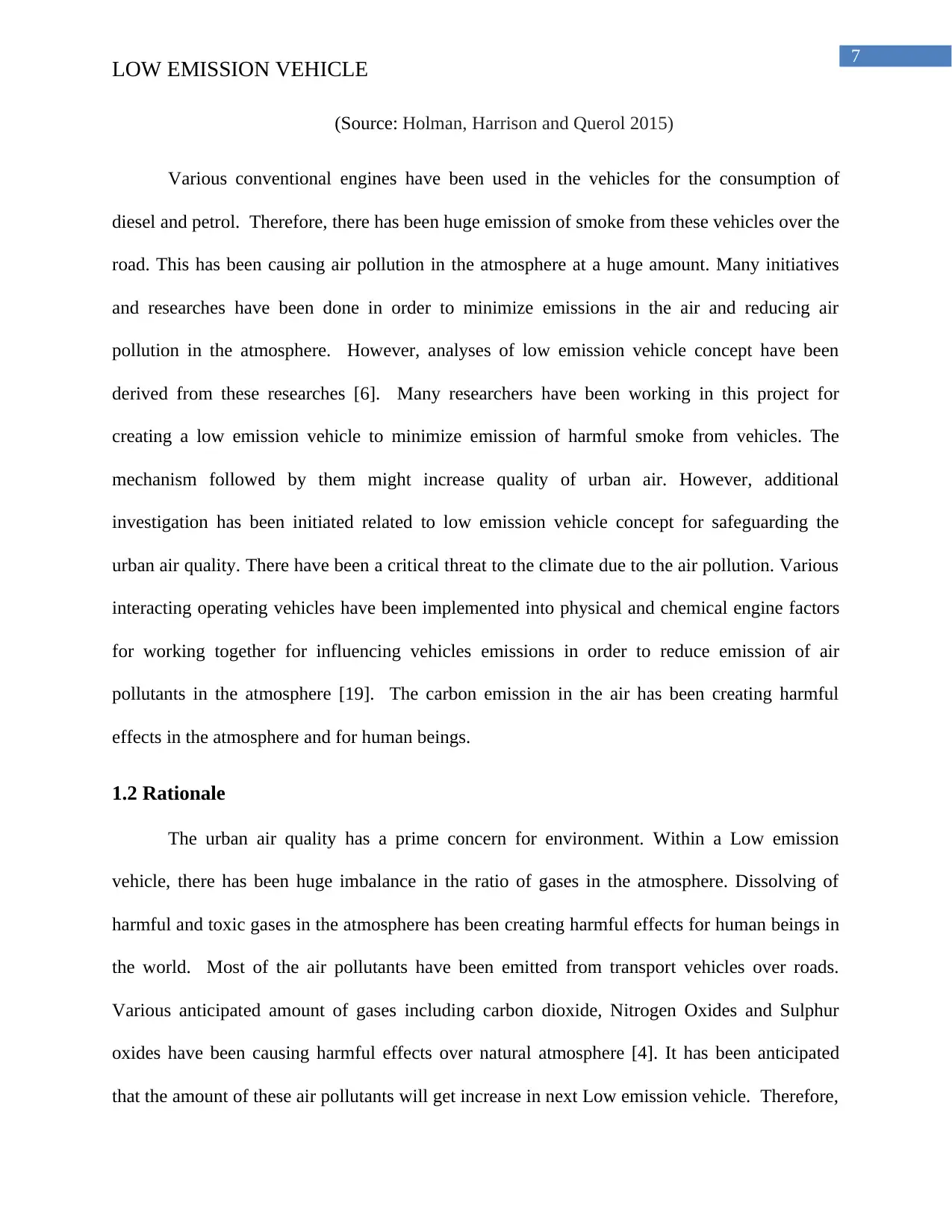
7
LOW EMISSION VEHICLE
(Source: Holman, Harrison and Querol 2015)
Various conventional engines have been used in the vehicles for the consumption of
diesel and petrol. Therefore, there has been huge emission of smoke from these vehicles over the
road. This has been causing air pollution in the atmosphere at a huge amount. Many initiatives
and researches have been done in order to minimize emissions in the air and reducing air
pollution in the atmosphere. However, analyses of low emission vehicle concept have been
derived from these researches [6]. Many researchers have been working in this project for
creating a low emission vehicle to minimize emission of harmful smoke from vehicles. The
mechanism followed by them might increase quality of urban air. However, additional
investigation has been initiated related to low emission vehicle concept for safeguarding the
urban air quality. There have been a critical threat to the climate due to the air pollution. Various
interacting operating vehicles have been implemented into physical and chemical engine factors
for working together for influencing vehicles emissions in order to reduce emission of air
pollutants in the atmosphere [19]. The carbon emission in the air has been creating harmful
effects in the atmosphere and for human beings.
1.2 Rationale
The urban air quality has a prime concern for environment. Within a Low emission
vehicle, there has been huge imbalance in the ratio of gases in the atmosphere. Dissolving of
harmful and toxic gases in the atmosphere has been creating harmful effects for human beings in
the world. Most of the air pollutants have been emitted from transport vehicles over roads.
Various anticipated amount of gases including carbon dioxide, Nitrogen Oxides and Sulphur
oxides have been causing harmful effects over natural atmosphere [4]. It has been anticipated
that the amount of these air pollutants will get increase in next Low emission vehicle. Therefore,
LOW EMISSION VEHICLE
(Source: Holman, Harrison and Querol 2015)
Various conventional engines have been used in the vehicles for the consumption of
diesel and petrol. Therefore, there has been huge emission of smoke from these vehicles over the
road. This has been causing air pollution in the atmosphere at a huge amount. Many initiatives
and researches have been done in order to minimize emissions in the air and reducing air
pollution in the atmosphere. However, analyses of low emission vehicle concept have been
derived from these researches [6]. Many researchers have been working in this project for
creating a low emission vehicle to minimize emission of harmful smoke from vehicles. The
mechanism followed by them might increase quality of urban air. However, additional
investigation has been initiated related to low emission vehicle concept for safeguarding the
urban air quality. There have been a critical threat to the climate due to the air pollution. Various
interacting operating vehicles have been implemented into physical and chemical engine factors
for working together for influencing vehicles emissions in order to reduce emission of air
pollutants in the atmosphere [19]. The carbon emission in the air has been creating harmful
effects in the atmosphere and for human beings.
1.2 Rationale
The urban air quality has a prime concern for environment. Within a Low emission
vehicle, there has been huge imbalance in the ratio of gases in the atmosphere. Dissolving of
harmful and toxic gases in the atmosphere has been creating harmful effects for human beings in
the world. Most of the air pollutants have been emitted from transport vehicles over roads.
Various anticipated amount of gases including carbon dioxide, Nitrogen Oxides and Sulphur
oxides have been causing harmful effects over natural atmosphere [4]. It has been anticipated
that the amount of these air pollutants will get increase in next Low emission vehicle. Therefore,
Paraphrase This Document
Need a fresh take? Get an instant paraphrase of this document with our AI Paraphraser
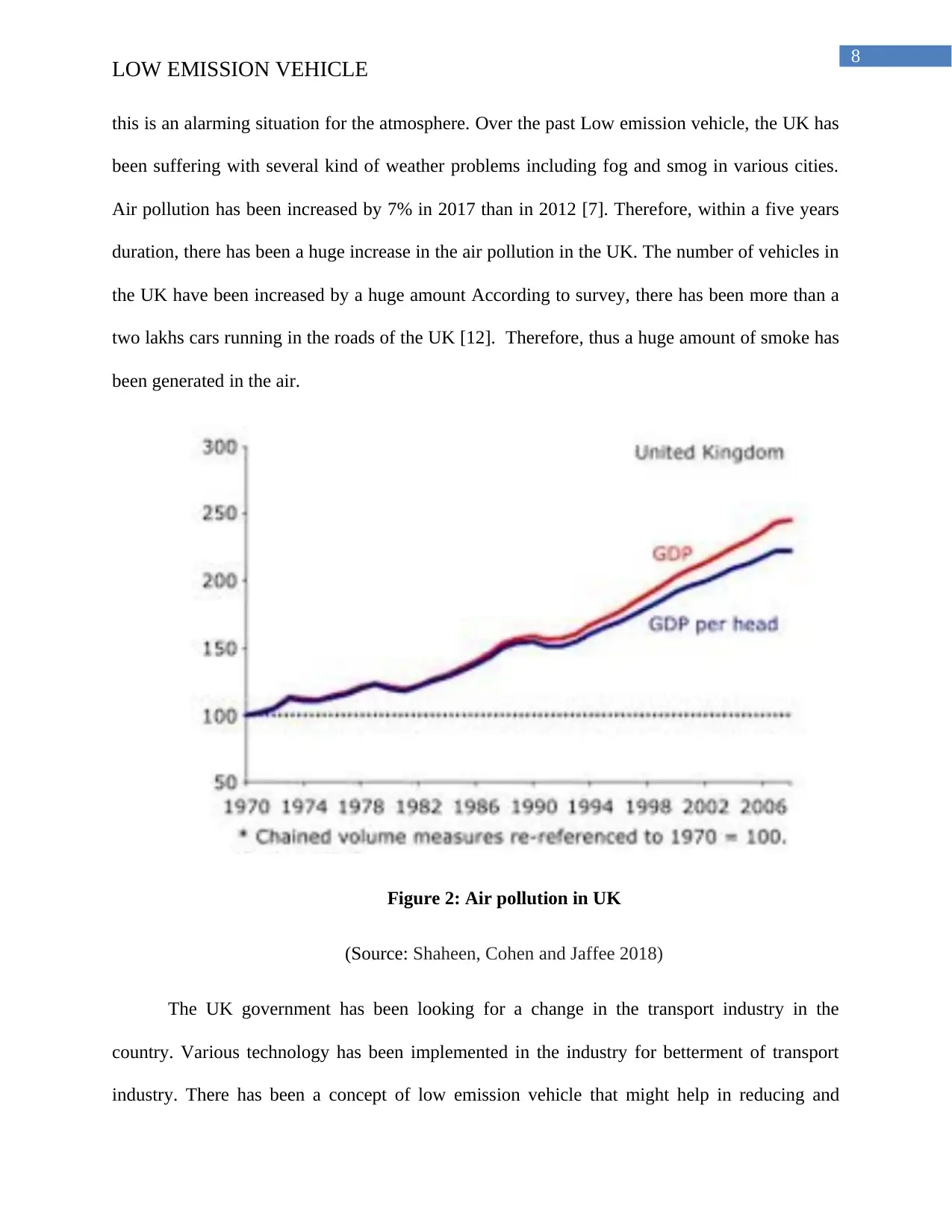
8
LOW EMISSION VEHICLE
this is an alarming situation for the atmosphere. Over the past Low emission vehicle, the UK has
been suffering with several kind of weather problems including fog and smog in various cities.
Air pollution has been increased by 7% in 2017 than in 2012 [7]. Therefore, within a five years
duration, there has been a huge increase in the air pollution in the UK. The number of vehicles in
the UK have been increased by a huge amount According to survey, there has been more than a
two lakhs cars running in the roads of the UK [12]. Therefore, thus a huge amount of smoke has
been generated in the air.
Figure 2: Air pollution in UK
(Source: Shaheen, Cohen and Jaffee 2018)
The UK government has been looking for a change in the transport industry in the
country. Various technology has been implemented in the industry for betterment of transport
industry. There has been a concept of low emission vehicle that might help in reducing and
LOW EMISSION VEHICLE
this is an alarming situation for the atmosphere. Over the past Low emission vehicle, the UK has
been suffering with several kind of weather problems including fog and smog in various cities.
Air pollution has been increased by 7% in 2017 than in 2012 [7]. Therefore, within a five years
duration, there has been a huge increase in the air pollution in the UK. The number of vehicles in
the UK have been increased by a huge amount According to survey, there has been more than a
two lakhs cars running in the roads of the UK [12]. Therefore, thus a huge amount of smoke has
been generated in the air.
Figure 2: Air pollution in UK
(Source: Shaheen, Cohen and Jaffee 2018)
The UK government has been looking for a change in the transport industry in the
country. Various technology has been implemented in the industry for betterment of transport
industry. There has been a concept of low emission vehicle that might help in reducing and
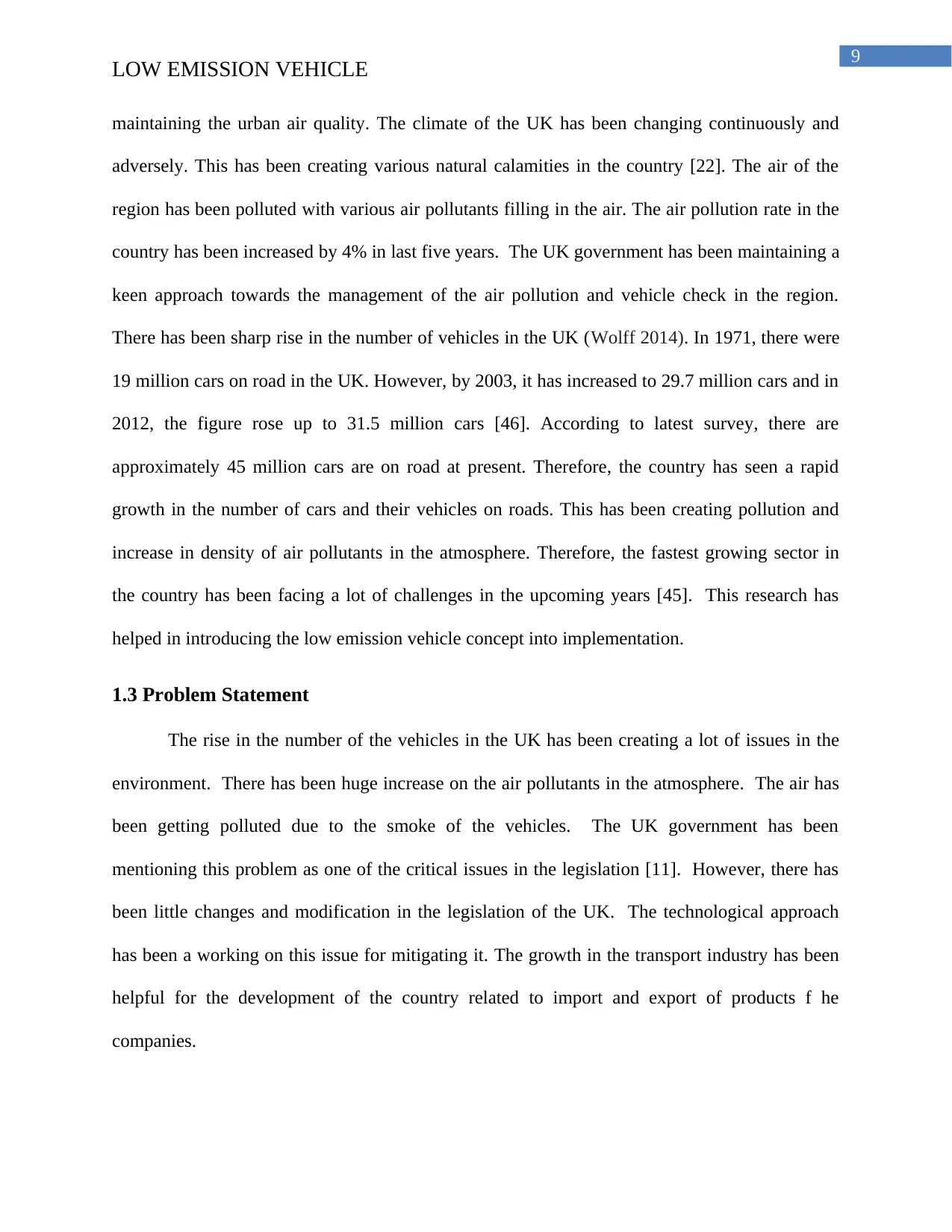
9
LOW EMISSION VEHICLE
maintaining the urban air quality. The climate of the UK has been changing continuously and
adversely. This has been creating various natural calamities in the country [22]. The air of the
region has been polluted with various air pollutants filling in the air. The air pollution rate in the
country has been increased by 4% in last five years. The UK government has been maintaining a
keen approach towards the management of the air pollution and vehicle check in the region.
There has been sharp rise in the number of vehicles in the UK (Wolff 2014). In 1971, there were
19 million cars on road in the UK. However, by 2003, it has increased to 29.7 million cars and in
2012, the figure rose up to 31.5 million cars [46]. According to latest survey, there are
approximately 45 million cars are on road at present. Therefore, the country has seen a rapid
growth in the number of cars and their vehicles on roads. This has been creating pollution and
increase in density of air pollutants in the atmosphere. Therefore, the fastest growing sector in
the country has been facing a lot of challenges in the upcoming years [45]. This research has
helped in introducing the low emission vehicle concept into implementation.
1.3 Problem Statement
The rise in the number of the vehicles in the UK has been creating a lot of issues in the
environment. There has been huge increase on the air pollutants in the atmosphere. The air has
been getting polluted due to the smoke of the vehicles. The UK government has been
mentioning this problem as one of the critical issues in the legislation [11]. However, there has
been little changes and modification in the legislation of the UK. The technological approach
has been a working on this issue for mitigating it. The growth in the transport industry has been
helpful for the development of the country related to import and export of products f he
companies.
LOW EMISSION VEHICLE
maintaining the urban air quality. The climate of the UK has been changing continuously and
adversely. This has been creating various natural calamities in the country [22]. The air of the
region has been polluted with various air pollutants filling in the air. The air pollution rate in the
country has been increased by 4% in last five years. The UK government has been maintaining a
keen approach towards the management of the air pollution and vehicle check in the region.
There has been sharp rise in the number of vehicles in the UK (Wolff 2014). In 1971, there were
19 million cars on road in the UK. However, by 2003, it has increased to 29.7 million cars and in
2012, the figure rose up to 31.5 million cars [46]. According to latest survey, there are
approximately 45 million cars are on road at present. Therefore, the country has seen a rapid
growth in the number of cars and their vehicles on roads. This has been creating pollution and
increase in density of air pollutants in the atmosphere. Therefore, the fastest growing sector in
the country has been facing a lot of challenges in the upcoming years [45]. This research has
helped in introducing the low emission vehicle concept into implementation.
1.3 Problem Statement
The rise in the number of the vehicles in the UK has been creating a lot of issues in the
environment. There has been huge increase on the air pollutants in the atmosphere. The air has
been getting polluted due to the smoke of the vehicles. The UK government has been
mentioning this problem as one of the critical issues in the legislation [11]. However, there has
been little changes and modification in the legislation of the UK. The technological approach
has been a working on this issue for mitigating it. The growth in the transport industry has been
helpful for the development of the country related to import and export of products f he
companies.
⊘ This is a preview!⊘
Do you want full access?
Subscribe today to unlock all pages.

Trusted by 1+ million students worldwide
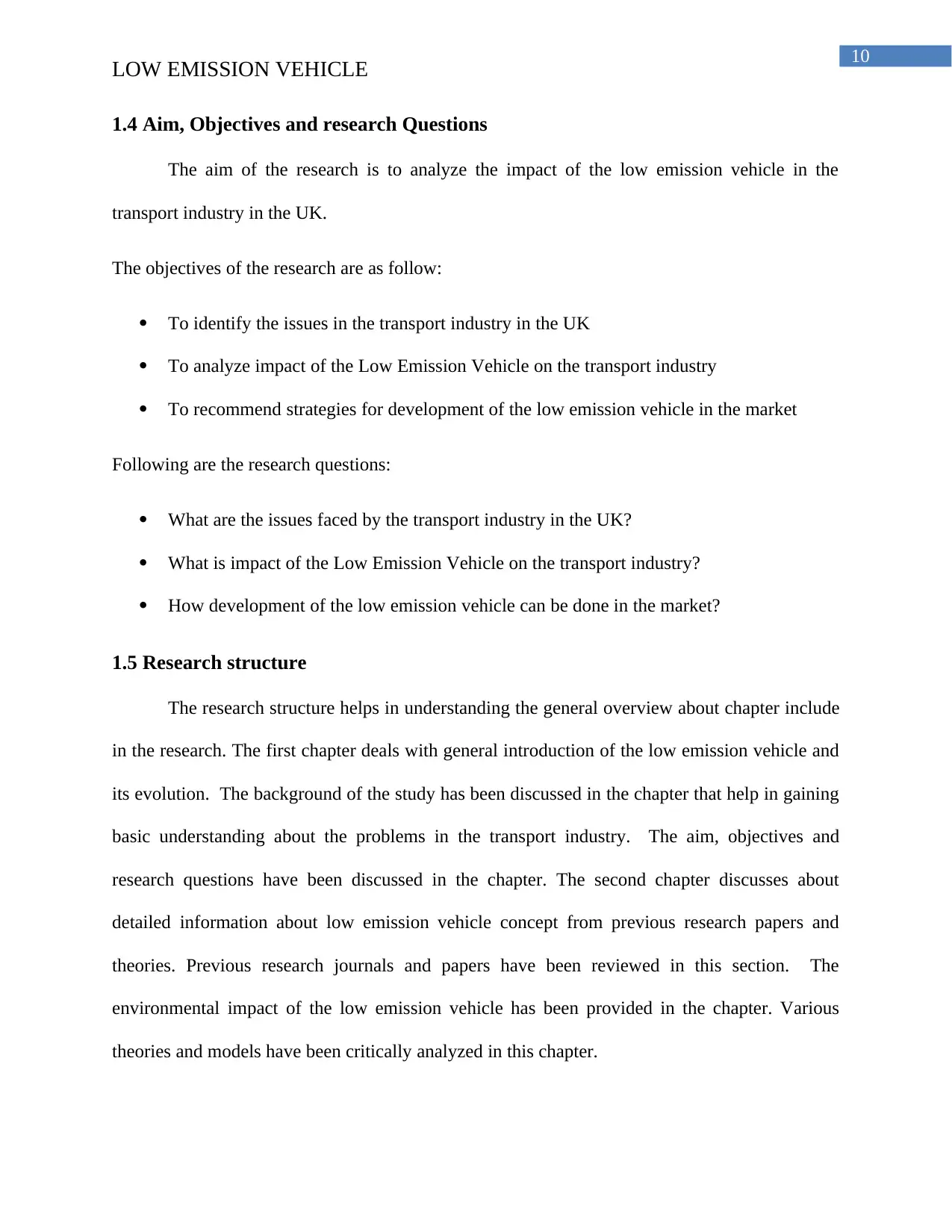
10
LOW EMISSION VEHICLE
1.4 Aim, Objectives and research Questions
The aim of the research is to analyze the impact of the low emission vehicle in the
transport industry in the UK.
The objectives of the research are as follow:
To identify the issues in the transport industry in the UK
To analyze impact of the Low Emission Vehicle on the transport industry
To recommend strategies for development of the low emission vehicle in the market
Following are the research questions:
What are the issues faced by the transport industry in the UK?
What is impact of the Low Emission Vehicle on the transport industry?
How development of the low emission vehicle can be done in the market?
1.5 Research structure
The research structure helps in understanding the general overview about chapter include
in the research. The first chapter deals with general introduction of the low emission vehicle and
its evolution. The background of the study has been discussed in the chapter that help in gaining
basic understanding about the problems in the transport industry. The aim, objectives and
research questions have been discussed in the chapter. The second chapter discusses about
detailed information about low emission vehicle concept from previous research papers and
theories. Previous research journals and papers have been reviewed in this section. The
environmental impact of the low emission vehicle has been provided in the chapter. Various
theories and models have been critically analyzed in this chapter.
LOW EMISSION VEHICLE
1.4 Aim, Objectives and research Questions
The aim of the research is to analyze the impact of the low emission vehicle in the
transport industry in the UK.
The objectives of the research are as follow:
To identify the issues in the transport industry in the UK
To analyze impact of the Low Emission Vehicle on the transport industry
To recommend strategies for development of the low emission vehicle in the market
Following are the research questions:
What are the issues faced by the transport industry in the UK?
What is impact of the Low Emission Vehicle on the transport industry?
How development of the low emission vehicle can be done in the market?
1.5 Research structure
The research structure helps in understanding the general overview about chapter include
in the research. The first chapter deals with general introduction of the low emission vehicle and
its evolution. The background of the study has been discussed in the chapter that help in gaining
basic understanding about the problems in the transport industry. The aim, objectives and
research questions have been discussed in the chapter. The second chapter discusses about
detailed information about low emission vehicle concept from previous research papers and
theories. Previous research journals and papers have been reviewed in this section. The
environmental impact of the low emission vehicle has been provided in the chapter. Various
theories and models have been critically analyzed in this chapter.
Paraphrase This Document
Need a fresh take? Get an instant paraphrase of this document with our AI Paraphraser
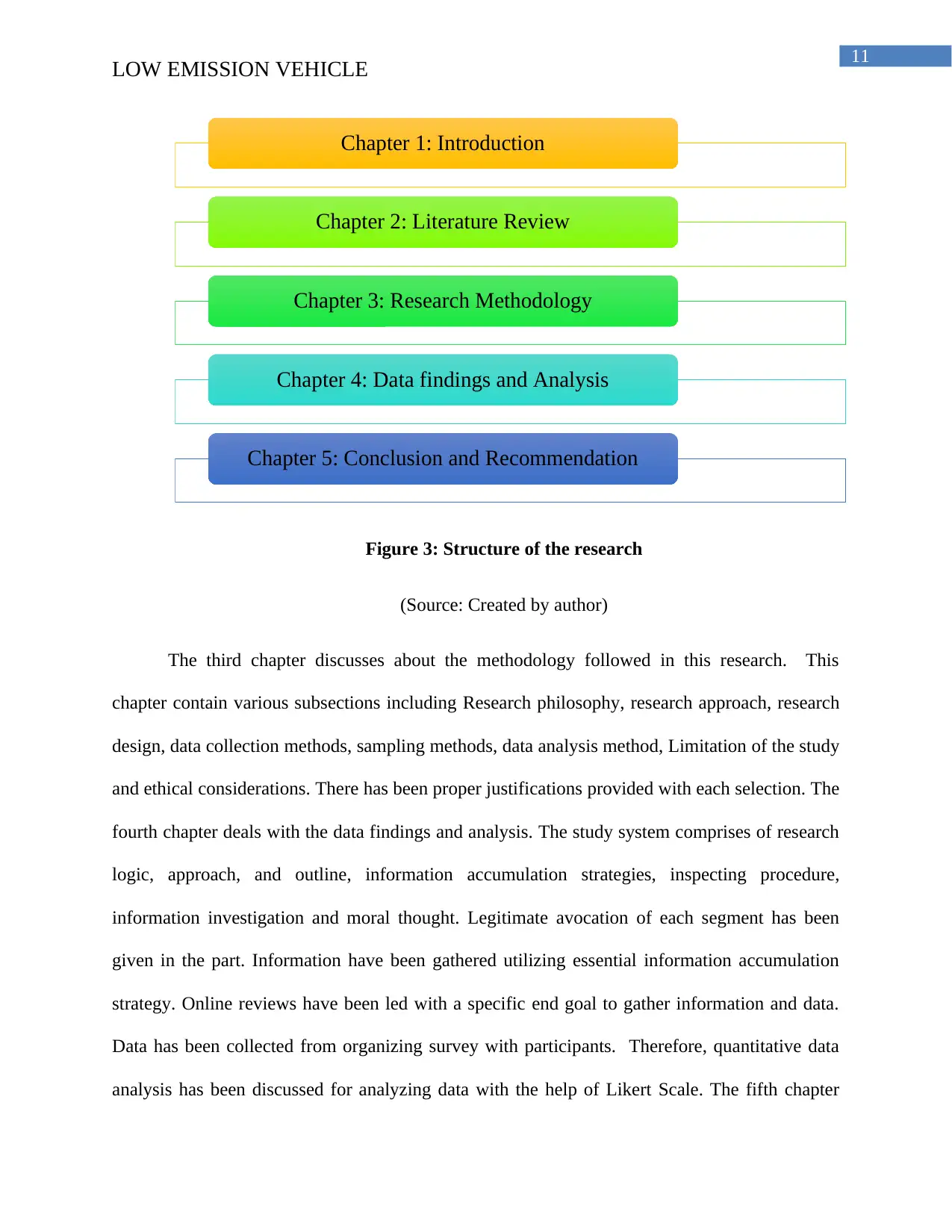
11
LOW EMISSION VEHICLE
Figure 3: Structure of the research
(Source: Created by author)
The third chapter discusses about the methodology followed in this research. This
chapter contain various subsections including Research philosophy, research approach, research
design, data collection methods, sampling methods, data analysis method, Limitation of the study
and ethical considerations. There has been proper justifications provided with each selection. The
fourth chapter deals with the data findings and analysis. The study system comprises of research
logic, approach, and outline, information accumulation strategies, inspecting procedure,
information investigation and moral thought. Legitimate avocation of each segment has been
given in the part. Information have been gathered utilizing essential information accumulation
strategy. Online reviews have been led with a specific end goal to gather information and data.
Data has been collected from organizing survey with participants. Therefore, quantitative data
analysis has been discussed for analyzing data with the help of Likert Scale. The fifth chapter
Chapter 1: Introduction
Chapter 2: Literature Review
Chapter 3: Research Methodology
Chapter 4: Data findings and Analysis
Chapter 5: Conclusion and Recommendation
LOW EMISSION VEHICLE
Figure 3: Structure of the research
(Source: Created by author)
The third chapter discusses about the methodology followed in this research. This
chapter contain various subsections including Research philosophy, research approach, research
design, data collection methods, sampling methods, data analysis method, Limitation of the study
and ethical considerations. There has been proper justifications provided with each selection. The
fourth chapter deals with the data findings and analysis. The study system comprises of research
logic, approach, and outline, information accumulation strategies, inspecting procedure,
information investigation and moral thought. Legitimate avocation of each segment has been
given in the part. Information have been gathered utilizing essential information accumulation
strategy. Online reviews have been led with a specific end goal to gather information and data.
Data has been collected from organizing survey with participants. Therefore, quantitative data
analysis has been discussed for analyzing data with the help of Likert Scale. The fifth chapter
Chapter 1: Introduction
Chapter 2: Literature Review
Chapter 3: Research Methodology
Chapter 4: Data findings and Analysis
Chapter 5: Conclusion and Recommendation

12
LOW EMISSION VEHICLE
focuses on conclusion and recommendations for the research study. The results have been
displayed with the help of charts and graphs. The linking with the objective has been done in
this section. Some recommendations have been provided in order to modify and enhance the
future study in the topic.
LOW EMISSION VEHICLE
focuses on conclusion and recommendations for the research study. The results have been
displayed with the help of charts and graphs. The linking with the objective has been done in
this section. Some recommendations have been provided in order to modify and enhance the
future study in the topic.
⊘ This is a preview!⊘
Do you want full access?
Subscribe today to unlock all pages.

Trusted by 1+ million students worldwide
1 out of 67
Related Documents
Your All-in-One AI-Powered Toolkit for Academic Success.
+13062052269
info@desklib.com
Available 24*7 on WhatsApp / Email
![[object Object]](/_next/static/media/star-bottom.7253800d.svg)
Unlock your academic potential
Copyright © 2020–2025 A2Z Services. All Rights Reserved. Developed and managed by ZUCOL.





